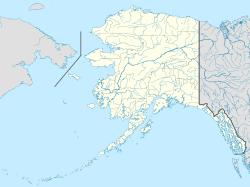Hydaburg, Alaska facts for kids
Quick facts for kids
Hydaburg
|
|
|---|---|
| Country | United States |
| State | Alaska |
| Incorporated | October 4, 1927 |
| Area | |
| • Total | 0.29 sq mi (0.76 km2) |
| • Land | 0.29 sq mi (0.76 km2) |
| • Water | 0.00 sq mi (0.01 km2) |
| Elevation | 23 ft (7 m) |
| Population
(2020)
|
|
| • Total | 380 |
| • Density | 1,301.37/sq mi (502.92/km2) |
| Time zone | UTC-9 (Alaska (AKST)) |
| • Summer (DST) | UTC-8 (AKDT) |
| ZIP code |
99922
|
| Area code(s) | 907 |
| FIPS code | 02-34460 |
| GNIS feature ID | 1422709, 2419401 |
Hydaburg is a city in the state of Alaska, United States. Its name comes from the Haida people, who are the native people of this area. In the year 2020, about 380 people lived in Hydaburg.
Where is Hydaburg Located?
Hydaburg is found in the Prince of Wales-Hyder Census Area. It is the city furthest south on Prince of Wales Island. The city sits on the north side of Sukkwan Strait. This strait connects to Cordova Bay.
Hydaburg has the only port and public road access on Cordova Bay. The city covers a total area of about 0.76 square kilometers (0.29 square miles). All of this area is land.
A Look at Hydaburg's Past
Hydaburg was created in 1911. It was formed when three Haida villages joined together. These villages were Howkan, Sukkwan, and Klinkwan. The people chose this spot because it had a good supply of water.
The town officially became a city in 1927. In 1938, the Hydaburg Cooperative Association was started. This group became the first recognized Village Council in Alaska. It helped the Haida people manage their community.
The area around Hydaburg was once an Indian Reservation from 1912 to 1926. Later, in 1949, the Hydaburg Indian Reservation was set up again. However, a court decision in 1952 ended this reservation status.
Hydaburg became a "first-class city" in 1973. Today, the Hydaburg Cooperative Association is still the recognized tribe. The Haida Corporation also works for the village under a special law for native lands in Alaska.
Who Lives in Hydaburg?
| Historical population | |||
|---|---|---|---|
| Census | Pop. | %± | |
| 1920 | 346 | — | |
| 1930 | 319 | −7.8% | |
| 1940 | 348 | 9.1% | |
| 1950 | 353 | 1.4% | |
| 1960 | 251 | −28.9% | |
| 1970 | 214 | −14.7% | |
| 1980 | 298 | 39.3% | |
| 1990 | 384 | 28.9% | |
| 2000 | 382 | −0.5% | |
| 2010 | 376 | −1.6% | |
| 2020 | 380 | 1.1% | |
| U.S. Decennial Census | |||
Hydaburg first appeared in the U.S. Census in 1920. It was counted as a village then. The city officially became incorporated in 1927.
In the year 2000, there were 382 people living in Hydaburg. Most of the people, about 85%, were Native American. About 9% were White. The rest were from other racial groups.
Many households had children under 18 living with them. The average household had about 2.87 people. The average family had about 3.60 people.
The population included people of all ages. About 35% were under 18 years old. About 7.9% were 65 years or older. The average age in the city was 32 years.
The median income for a household was $31,625. This means half of the households earned more, and half earned less. About 24% of the people in Hydaburg lived below the poverty line.
See also
 In Spanish: Hydaburg para niños
In Spanish: Hydaburg para niños


